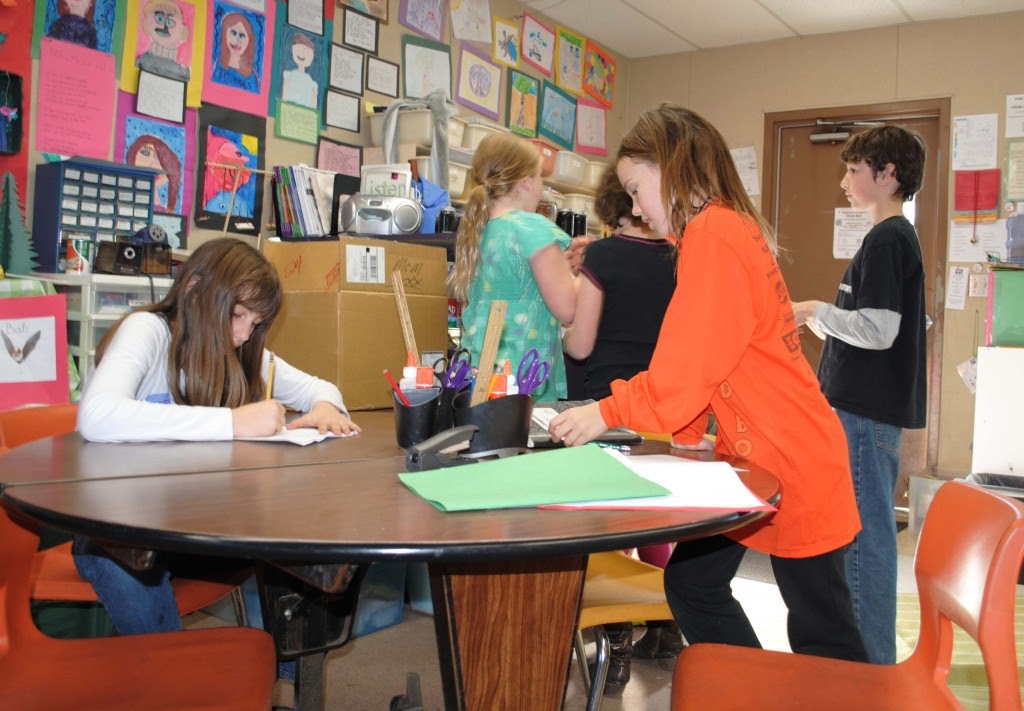EDCUCATIONAL ENVIRONMENT & CLASSROOM STRUCTURE

Educating the “whole child” is the tenet that drives the environment within each classroom and allows for the academic, social, emotional, creative, aesthetic and physical growth, and development of each student. The classrooms will all be similar in a variety of ways, part of the “common thread” that aligns Open Classroom classrooms with its philosophy. Classrooms will be, at all times, “kid-friendly” and developmentally appropriate.
Classrooms will be warm and welcoming. They will always display student artwork, writing, and projects both on-going as well as completed in a variety of curriculum disciplines. These student artifacts will provide evidence of past, current, and sometimes future learning.
Each classroom will have a large, open space for gathering, where the entire classroom’s learning community (students, parents, and teacher) gathers several times each day. Everyone will be seated together on the floor, for a wide variety of activities: planning and organizing, business and announcements, sharing, problem-solving, curriculum discussions, whole class lessons, read aloud, guest speakers, and presentations by students, parents or guests.
Classrooms will each have a separate space, e.g., a loft, which allows students the opportunity to work alone or with others in a smaller, more intimate work-space. Rooms may have sofas, comfortable over-stuffed chairs, rocking chairs, and/or unusual furniture items that will add to the kid-friendly environment of the learning space. Rooms will have a variety of tables that support small group learning. In addition, each classroom will have independent work-spaces for either individual or partner work to occur. Because collaboration is a vital and key element of the Open Classroom philosophy, students will move throughout the classroom, working with others and seeking help and support as needed. Each classroom will also provide teachers and parents space, for announcements, literature, scheduling, curriculum supplies, and community materials.
Blended grade classrooms (multi-age) are an important element in our school. Educational research shows that multi-aged learning environments facilitate individualized instruction where teachers focus on each student’s needs rather than grade level expectations. They also broaden the social peer group for children, offering a wider possibility of friendship choices.

In tune with the Open Classroom philosophy of being a “community of learners,” all classrooms will have items that support this sense of community. Classrooms may not have individual student desks but instead, the classrooms may provide shared tables and spaces within the classrooms where students may benefit from group work experiences. Supplies (paper, crayons, rulers, scissors, compasses, staplers, etc.) will all be located in a shared, community space, to be used as needed by anyone. Ideally, each classroom will support a large area, or “kitchen”, for cooking and nutrition, science learning, and art. Each student will have frequent and easy access to the computers. Students may have a personal mailbox for messages and notes, as well as an individual “cubby”, file box, tote tray, or locker for personal books or learning materials. Many times during a school day small groups of students may work outside their own classroom, sometimes needing more space to spread out, sometimes needing privacy to produce a play or work on a readers’ theater workshop. This space will be considered part of the Open Classroom learning environment.
Students and co-opers may meet in small groups in other public spaces in the school, or outside (e.g., the hallways, garden, or playgrounds). Also, many Open Classroom learning opportunities will take place off campus. This will be facilitated by the presence of parents and other community partners who can assist in planning off-campus activities and in transporting and managing groups of students at a variety of learning venues.
The Open Classroom students will produce a variety of projects throughout the school year, as supported by the Open Classroom philosophy that children learn by being actively involved in the learning process. The Open Classroom requires large spaces to store on-going learning projects until projects are completed and shared with classmates, parents, and frequently other classrooms. Teachers also need room to store their teaching and curriculum supplies. The Open Classroom will have a large and extensive children’s library, with multiple copies of books for literature studies. This library will be used and shared by all Open Classroom classrooms. The Open Classroom will also have a large and extensive parent resource library, supporting parents learning about the Open Classroom philosophy of education, curriculum, and co-oping. In addition, the Open Classroom will have “overall program” storage for large or periodically used items (e.g., Annual Carnival and Winter Concert props and decorations).
Finally, it will be expected that the upper grades will have a common area where they can meet together to organize their day using planners or other tools, work on current projects they have going on, catch up on homework, seek tutoring or mentoring from adult facilitators, and socialize.
